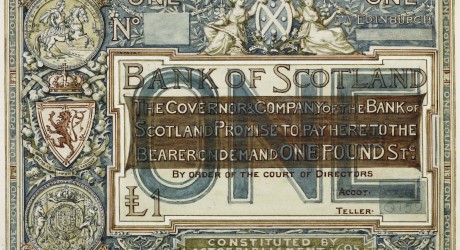THE Bank of Scotland’s historical records dating from 1695 – 2001 have been inscribed on UNESCO’s UK Memory of the World Register.
It was one of only 20 collections selected this year from libraries, archives and museums across the UK, to represent the country’s outstanding heritage.
The announcement was made this week at the tenth meeting of the International Advisory Committee (IAC) of UNESCO’s Memory of the World Programme, held in Manchester.
One of the most complete and wide-ranging business archives in the country, the Bank of Scotland records join entries on the UK Register spanning over 1,100 years of history.
Held by Lloyds Banking Group Archives in Edinburgh, the Bank of Scotland records are a major source for the economic and social history of Scotland from the late 17th century.
Examples of the astonishing range of records in the Bank of Scotland collection include:
* A complete run of the Bank’s minutes, dating back to the first meeting of its shareholders in 1696. The meeting was held in Patrick Steill’s tavern in Edinburgh’s Old Town.
* A subscription ledger recording the names of the Bank’s first shareholders (or proprietors as they were then known) in 1695. These included the Marquess of Tweeddale, Lord High Chancellor of Scotland.
* Branch records dating back to the establishment of the Bank’s first branches in Dumfries and Kelso in 1774.
* A comprehensive collection of Bank of Scotland banknotes (and forgeries), including the earliest surviving Scottish banknote from 1716.
* Photographs, architectural plans, advertising material, and staff records.
Country-level Memory of the World Registers exist around the globe, helping to promote documentary heritage of national significance.
The international-level register includes items from the UK such as the 1215 Magna Carta, the Mappa Mundi and the film ‘The Battle of Somme’.
The UK Memory of the World programme is part of UNESCO’s work to promote the preservation of and access to the world’s archive holdings and library collections.
David Dawson, chair of the UK Memory of the World Committee, commented: “We were incredibly impressed by the diversity and richness of this year’s nominations to the register.
“The Bank of Scotland’s historical records are one of the UK’s most exceptional documentary riches helping to provide a record of why we are what we are as a nation today.”
Seonaid McDonald, head of Archives and Museums (Scotland) at Lloyds Banking Group said: “It is fantastic that UNESCO has recognised the iconic status of Bank of Scotland’s historical records. Inclusion in the Memory of the World Register highlights their cultural importance, not just to Lloyds Banking Group, but to the wider national and international community.”
Researchers can access the Bank of Scotland records by appointment. Please contact Lloyds Banking Group Archives for further details.
Several iconic items from the Bank of Scotland collection – including the Bank’s Founding Act from 1695 – are on display at the Museum on the Mound in Edinburgh.
Further information on Bank of Scotland:
Bank of Scotland was founded by an Act of the old Scots Parliament, on 17th July 1695. It is the only institution founded by that body which still exists today.
Bank of Scotland began issuing banknotes in 1696 and was the first bank in Europe to successfully launch a paper currency. The bank still issues its own notes today, making it the longest continuous banknote issue in the world.
In 1959, Bank of Scotland became the first UK bank to introduce a computer for centralised accounting.
In the 1970s, the bank was at the forefront of North Sea Oil finance. Such was its expertise in this field that it became known as ‘The Oil Bank’.
In 1985, Bank of Scotland launched the UK’s first electronic home banking service, known as HOBS (Home and Office Banking Service). Customers could actively manage their accounts via a TV screen and telephone link-up, long before the internet was widely available.
ENDS
Notes to editors:
Bank of Scotland is part of Lloyds Banking Group, the UK’s largest retail bank and Scotland’s largest financial services employer. Established in 1695, Bank of Scotland is the UK’s oldest surviving clearing bank. Our goal is to be the best financial services provider in Scotland. We believe this means we must build a leadership position not on the basis of scale but on the foundations of reputation and recommendation.
For further information:
Name: Karen Morrison, McGarvie Morrison Media
Telephone: 0141 221 9041
Email: karen@mmm.pr
PHOTO: Design for Bank of Scotland £1 note, 1884 series, by William Black (Photograph by Antonia Reeve)
MEDIA RELEASE posted by McGarvie Morrison Media. You too can post media releases (aka press releases) on allmediascotland.com. For more information, email here.
Contact: Karen Morrison
Phone: 07771936726
Email: karen@mmm.pr
Website: http://www.mmm.pr






